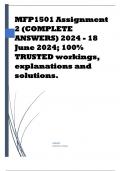MFP1501 Assignment
2 (COMPLETE
ANSWERS) 2024 - 18
June 2024; 100%
TRUSTED workings,
explanations and
solutions.
ADMIN
[COMPANY NAME]
,Question 1 Jacob and Willis (2003) outline hierarchical phases
through which multiplicative thinking develops, which include
one-to-one counting, additive composition, many-to-one
counting, and multiplicative relations. Discuss each phase to
show how best you understand it. N.B. It should not be the
same. Be creative. (20)
Sure, let's delve into each of these phases outlined by Jacob and
Willis (2003) to understand the progression of multiplicative
thinking. I’ll describe each phase in a unique and detailed
manner.
One-to-One Counting
Description: One-to-one counting is the foundational stage
where children learn to associate one object with one count. This
phase focuses on the ability to count objects individually,
ensuring each object is paired with a unique number in
sequence. For instance, if a child has five apples, they count
each apple once, reaching the number five.
Understanding: In this phase, the child is developing a basic
sense of quantity and number correspondence. This skill is
crucial as it sets the stage for understanding that numbers
represent quantities and that these quantities can be compared
and manipulated. Think of it as laying the bricks for a house;
each brick (number) is placed carefully to build a strong
foundation.
Additive Composition
, Description: Additive composition involves recognizing that
numbers can be broken down into smaller parts and recombined.
Children begin to understand that numbers can be added
together to form new numbers. For example, they learn that 3
and 4 make 7.
Understanding: Here, the child moves beyond simple counting
to grasp the concept of addition. They see numbers as flexible
entities that can be combined in various ways to form larger
numbers. This phase is akin to a chef learning to mix different
ingredients to create new recipes. It’s about seeing the potential
combinations and how they can come together to create
something new.
Many-to-One Counting
Description: Many-to-one counting, often referred to as skip
counting, involves counting groups of objects instead of
counting each object individually. For instance, instead of
counting 1, 2, 3, 4, 5, a child might count 2, 4, 6, 8, 10, grouping
objects in twos.
Understanding: This phase is a significant leap from one-to-
one counting, introducing the child to the concept of grouping
and efficiency in counting. It’s like moving from individual
storytelling to understanding chapters in a book; each group
represents a chapter with several pages (individual counts)
within it. This prepares the child for more complex operations,
as they see the efficiency and pattern in numbers.
Multiplicative Relations




